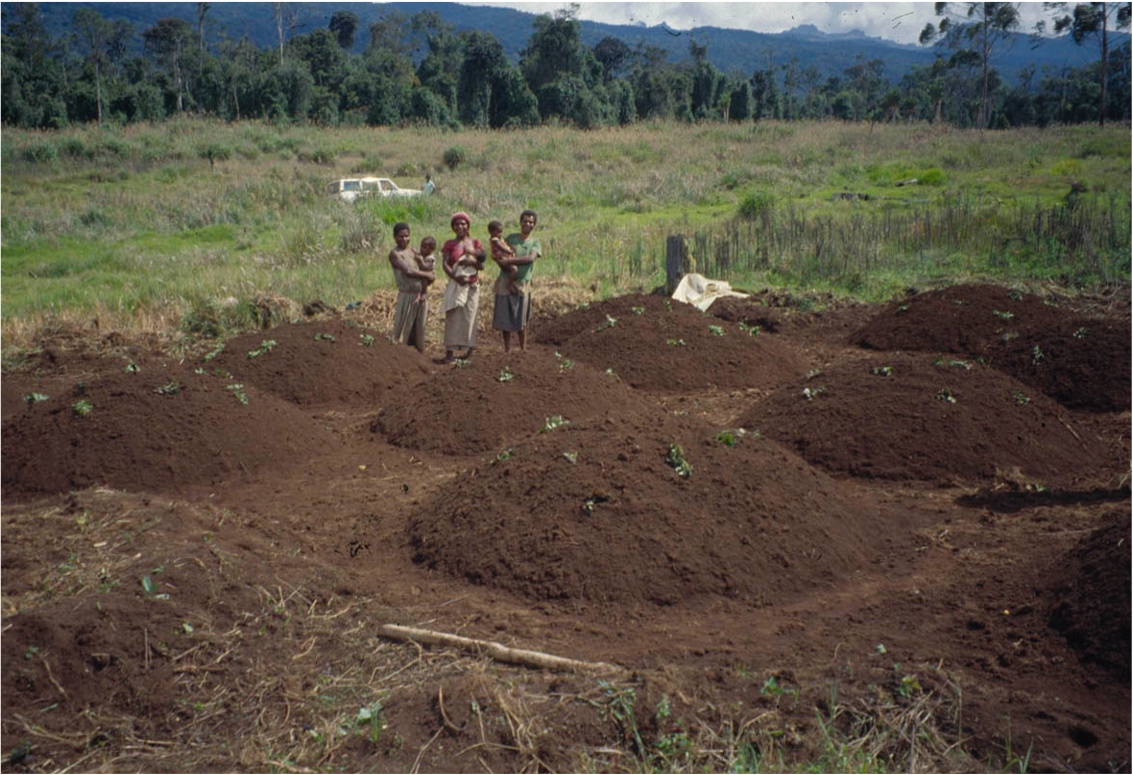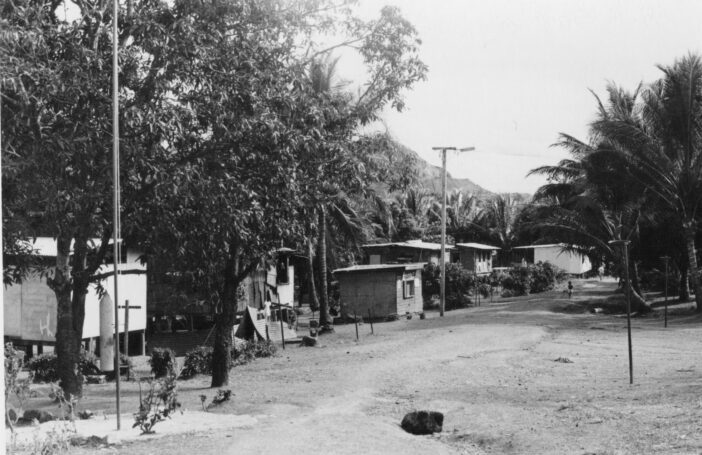In their blog ‘PNG: the hungry country’, Manoj Pandey and Stephen Howes have raised an important topic – food insecurity. But I disagree with their conclusion that in Papua New Guinea (PNG) ‘hunger is widespread’ and that ‘many people are simply not eating enough’. There are, however, a few locations where people are chronically short of food; localised food shortages do happen occasionally; and widespread severe food shortages do occur, typically a decade or more apart. Importantly, both protein and energy intake of many small children is limited because of the bulky nature of traditional energy foods.
The focus of this blog is on rural villages, where over 80% of the PNG population resides, and on the consumption of carbohydrate-rich energy foods such as root crops, sago and banana. This was the focus of my 2000 publication on food security in PNG, quoted in the ‘hungry country’ blog. There are also issues with the quality of the diet of many Papua New Guineans, including low intake of protein, oils/fats, iron, iodine and vitamin A, but these are not addressed here.
By way of background, I have been continuously engaged in agricultural development, research and training in PNG for many years, seeking to understand the extent and causes of short-term and long-term food shortages. The causes of food shortages in the PNG Highlands were examined in my doctoral research.
Over the past 10 years, I have visited hundreds of food gardens in rural and remote villages, and discussed food issues in depth across many parts of Hela, Southern Highlands, Western Highlands, Jiwaka, Eastern Highlands, Morobe, Central, Gulf, New Ireland and East New Britain provinces. Part of this period included widespread food shortages caused by drought and frost in much of rural PNG in 2015–16. However, in non-drought periods, I rarely encountered locations where carbohydrate food was insufficient over wide areas.
Surveys can generate misleading information on certain topics, including food intake. From my own experience, villagers sometimes say that food is scarce. However, on further probing, it is apparent that their favourite food is not readily available, so they are eating more of a less favourable food. This is particularly the case where there has been a change in foods – for example, where taro or yams have been replaced with more recently adopted foods such as sweet potato, cassava or imported rice.
People in the PNG Highlands have also tended to inflate survey responses. For example, in the 2015–16 food shortages, phone surveys conducted on behalf of the World Food Programme reported that people had no food in Gumine District in Simbu Province. Several of us queried this based on information from our contacts in that area. My colleague Matt Kanua led a team to the area and found that, as we suspected, food was somewhat scarce but people were not starving. A good example of the more detailed research required on food supply is that given by Dr John Sowei in his response to the ‘hungry country’ blog. Food intake studies based on recall by informants are difficult to conduct and are best done by highly experienced nutritionists or agriculturalists.
There are a few rural locations where food is chronically scarce, and this is normally addressed through trade. People on some small islands obtain food from villagers on nearby larger islands in exchange for non-food items. On the PNG mainland, and on some larger islands, people obtain food from those living in other agro-ecological zones – that is, where rainfall patterns are different and food is easier to grow. However, there are a few places, such as the Carteret Islands east of Buka, that are too distant from larger islands to trade for food and food is chronically short.
Food is sometimes scarce for other rural villagers. The reasons for short-term shortages vary, and include extended periods of exceptionally high rainfall, which prevent access to food gardens; lack of garden activity for long periods following a series of deaths in a community; and an inability of men or women to contribute to food production because of illness, extended absences or other reasons.
More prolonged and widespread food shortages are caused by climatic extremes (drought, frost, excessively high rainfall) and, in the PNG Highlands, cycles of particularly high then particularly low planting rates of the main staple food, sweet potato. Major droughts (and repeated frosts above 2200 m altitude) have caused serious shortages, both historically and in recent decades. Over the past 50 years, these have occurred in 1972, 1982, 1997–98 (the most severe since the early 1940s) and 2015–16.
It is important to note that the Demographic and Health Survey (DHS) – a source for ‘the hungry country’ – was conducted in 2016, 2017 and 2018. Food shortages associated with the 2015–16 drought and frosts extended from mid-2015 to mid/late 2016 (and into 2017 in some high-altitude locations in Enga and nearby places). Hence, it is unsurprising that the DHS found that many rural people were short of food in the 12 months prior to the survey.
While I disagree with the main conclusions of the ‘hungry country’ blog, it is a useful contribution that has raised some important issues, including the lack of recent high-quality statistical data on food production, consumption and related issues. Other changes in rural PNG that affect food availability and consumption, most of which are not well understood, include:
- increasing landlessness as many rural villagers migrate from more remote and generally less favourable environments to locations closer to highways and urban areas;
- the declining terms of trade for those growing and selling coffee and cocoa – thus many rural people have less cash with which to purchase food when subsistence sources are inadequate;
- a rapidly increasing population (which has increased nationally from 2 million in 1966 and will probably pass 10 million in late 2021 or soon after), putting pressure on agricultural land, particularly on many small islands and in parts of the Central Highland; and
- an increase in the number of people living in squatter camps and peri-urban areas near the larger cities and towns, often with precarious livelihood options.
There are numerous causes of localised food shortages and several causes of widespread and often longer-lasting shortages in PNG. Despite this, most rural villagers have access to an adequate supply of energy (carbohydrate) foods for most of the time. I would never describe PNG as ‘a hungry country’.






Good day to you
A well written article
A brief comment In general terms, and I have no degree, fellowship, academic basis or data to substantiate my opinions but … food is not a major issue in PNG – most land is very arable and the only thing that doesn’t grow here is the hair on my head.
In my view:
* As the population gravitates to an urbanisation which is not equipped, geared or resourced to manage this increase, so do the living from the land skills deteriorate.
* Most farmers are subsistence farmers – growing plenty – eating what we can and not crop-sharing or rotating.
* Staple crops are grown and as the authors state Protein (meat) is a key issue in our people’s diet – lack of it. We don’t have a cattle or livestock market, ASF is concerning for our Piggeries. We could build 10 more Mainland Tablebirds and Zenags (plus the Speik project) and still not have enough Kakaruk for our people.
* Greens and starchy foods are the main diet.
* High sugar content in breads, soft-drinks etc, is increasing diabetes and other blood issues (I am not a doctor, nor do I have stats to validate this statement).
* The data or evidence in our Health and Govt system does not provide real numbers which therefore understates the real issues.
PNG has an enormous opportunity to build a cold-chain domestic market which is self sustaining, employs people, ensures a spread of different local foods and produce to parts of the country that cannot cultivate them – THAT is where our focus should be with organisations like GrowPNG etc – THEN look at export opportunities.
Just some simple bullet points – which can be shot down and jumped on at any time
Have a great day
Regards
JB
John Byrne
President – LCCI
#ForBetterLaeBusiness2021
Poor road maintenance contributes to food insecurity. Fix the roads and rural Papua New Guineans can sell their agricultural produce. DAL should have much greater input into funding for key agricultural road infrastructure.
One way to clarify this debate is to examine rates of child stunting in different parts of PNG.
Hi Scott,
I agree with your comment. It is nearly 20 years since child stunting data were published in PNG. I, with the help of the CARE earthquake recovery team, carried our a malnutrition survey of about 400 children less than 5 years old in the Strickland Bosavi Region (SBR) of Western and Hela provinces and that clearly shows unacceptable levels of stunting, particularly in dispossessed children (refugees from earthquake devastation of their villages and gardens) measured at Huiya, Hela Province. I have drafted a blog on this. Importantly, the survey data has guided a small Rotary humanitarian project to alleviate malnutrition I have conducted over the last few years in SBR. I hope to expand this work to achieve sustainable adoption of more nutritious, balanced diets for pregnant and breast feeding women, babies and children less than 5 years old. I think this is an urgent need in many parts of rural PNG.